

Damion Smy
Boxy new KGM Musso unveiled to take on HiLux and Ranger ahead of Australian launch
9 Hours Ago
There's little extra utility and certainly no extra sport in this sport-utility vehicle, but the Kia Stonic S is pleasant with a manual transmission.
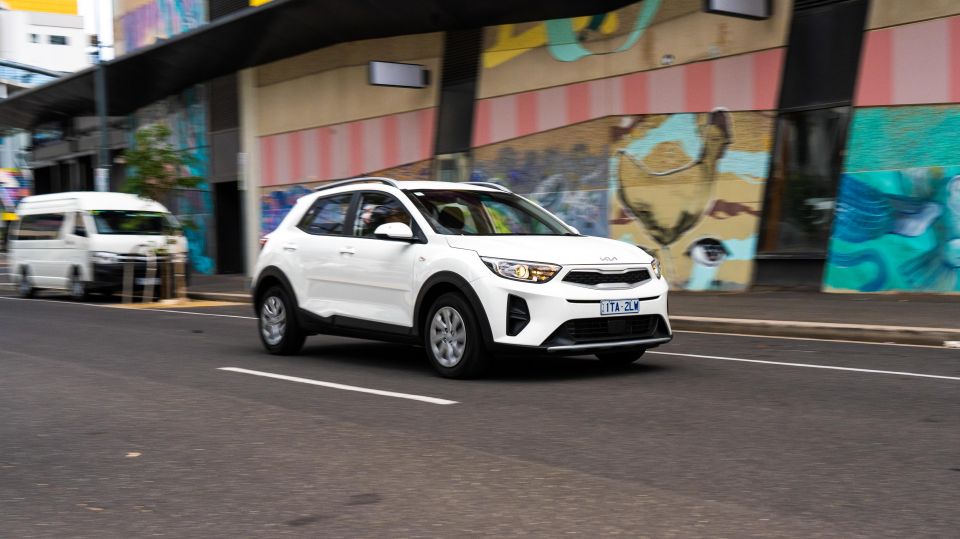
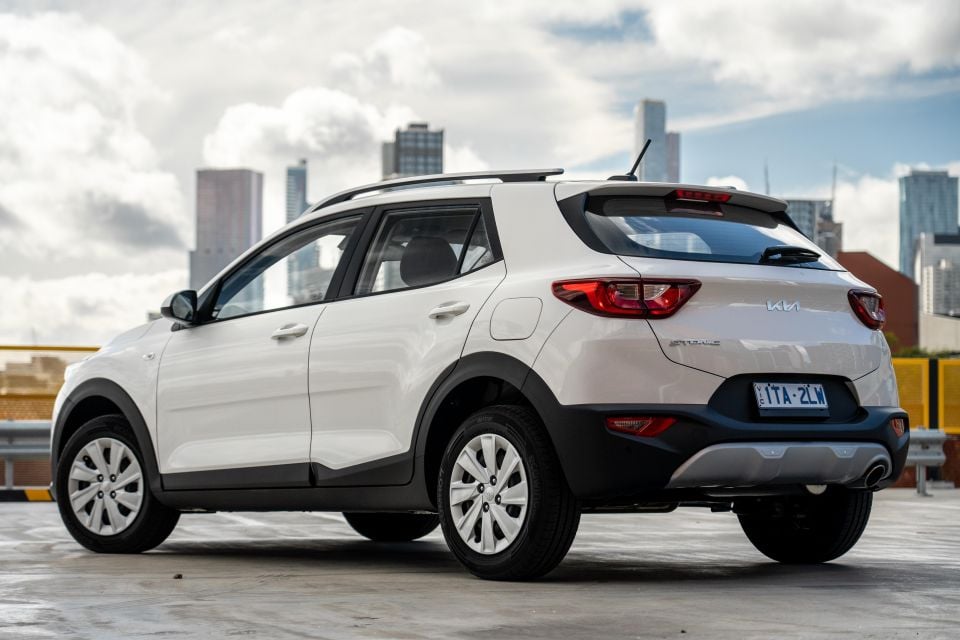

Quickly see how this car stacks up against its competition. Select any benchmark to see more details.
Where expert car reviews meet expert car buying – CarExpert gives you trusted advice, personalised service and real savings on your next new car.
My initial instinct was to scoff at the Kia Stonic S.
Not because this is a base-spec small crossover wearing wheel covers and a refrigerator white paint job, rather it’s because this is essentially a Rio with an (admittedly quite stylish) new body, which was first launched in 2017 in Europe and took until last year to finally get here.
It’s just over $2000 more than the equivalent Rio for no extra space, an almost identical interior, the same powertrain, an ever-so-slightly higher ride height and no real additional capability to speak of.

No, ‘SUV’ doesn’t have to mean some all-terrain four-wheel drive these days, but even by today’s generous standards the Stonic hardly seems worthy of the SUV moniker.
You should just look at the Kia Rio S, then, instead of this breathtakingly cynical small SUV, right? Not quite.
Put the two spec sheets against each other, at least without looking too closely, and you may begin to see why the new (to Australia) Stonic outsold the Rio last year. And take it for a drive and you’ll see how it would make a good first car, at least in manual S guise.
By the way, if you were wondering, the Stonic isn’t named after some picturesque Eastern European town. Instead it’s a portmanteau of “speedy” and “tonic”.
The cheapest member of the Stonic family, the S manual is priced at $21,990 before on-road costs or $24,690 drive-away. Opting for the auto adds an extra $1500 to either price.
The Rio S manual, in contrast, is priced at $19,690 before on-roads or $21,490 drive-away, while the mid-range Sport manual is $21,190 list or $23,490 drive-away.
The Stonic occupies the more affordable end of what the Federal Chamber of Automotive Industries (FCAI) calls the Light SUV segment. Its priciest model, for example, is priced in line with entry-level variants of some similarly-sized crossovers.
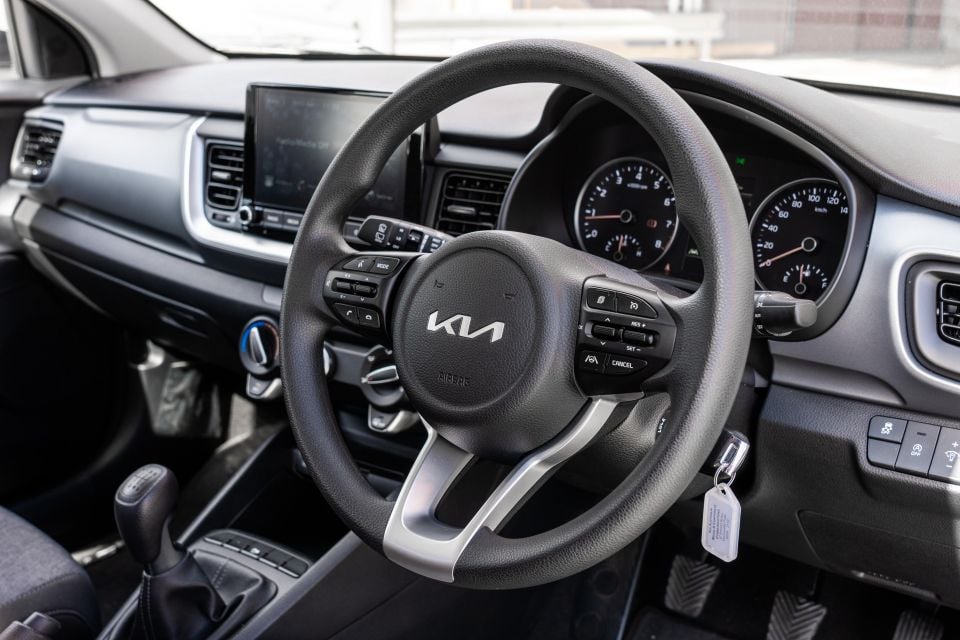
That means there’s not a massive list of rivals for the absolute base Stonic. Its key rivals are the Hyundai Venue manual ($21,240) and the Mazda CX-3 Neo Sport manual ($23,190).
Let’s consider for a second that a new Stonic could be replacing something like an old Toyota Corolla in a buyer’s garage. 20 years ago, you could get a new Corolla hatch for around $19,990 before on-roads. Adjust that for inflation and that’s over $30,000 in today’s money.
But the Stonic is almost identical in size to a Corolla hatchback from 20 years ago and packs more standard kit, including features we take for granted these days like power windows and cruise control. Where the Stonic suffers compared to a 20-year old Corolla or Nissan Pulsar, however, is under the bonnet. More on that later.
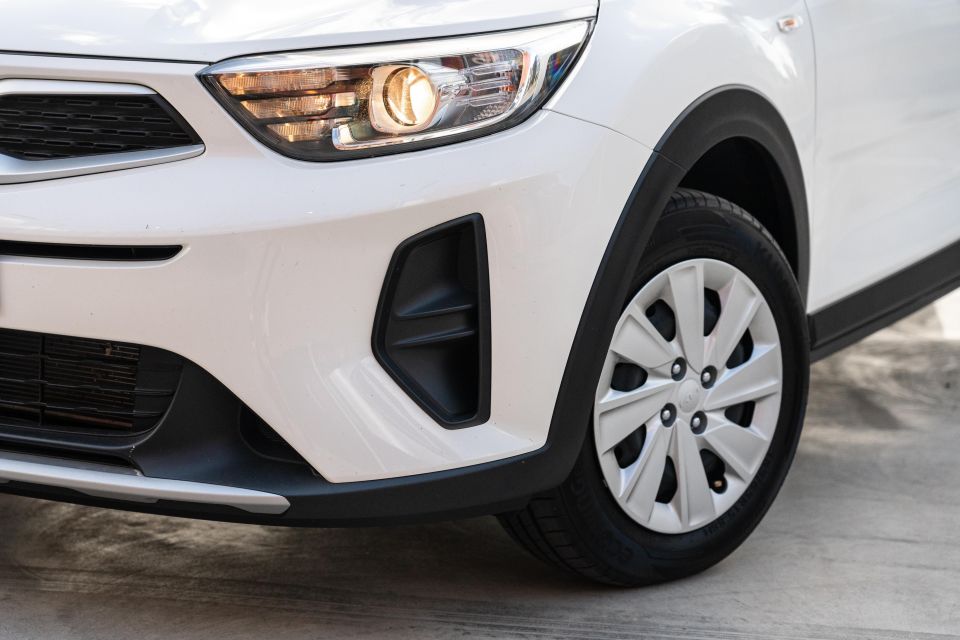

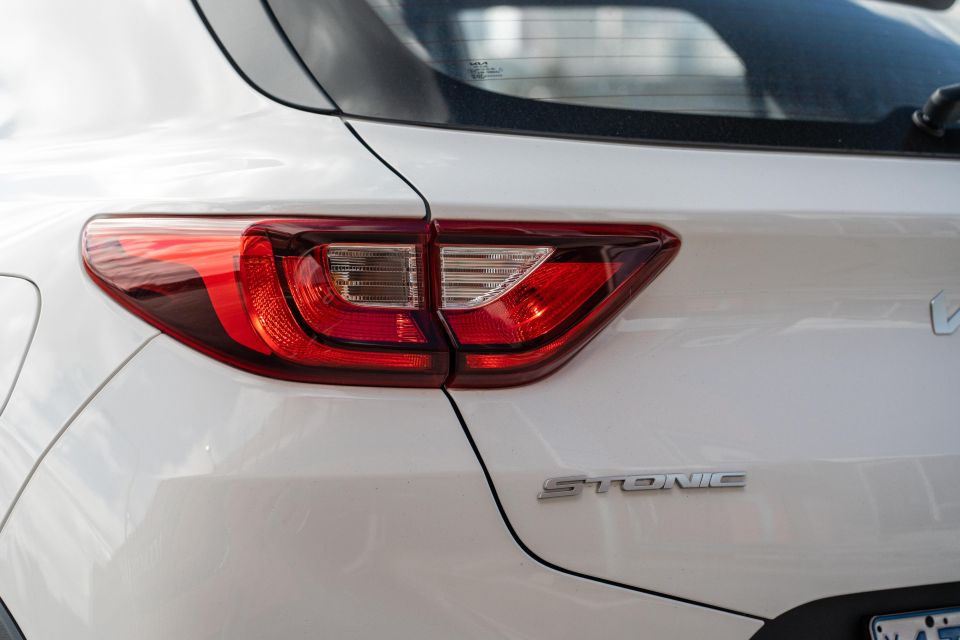
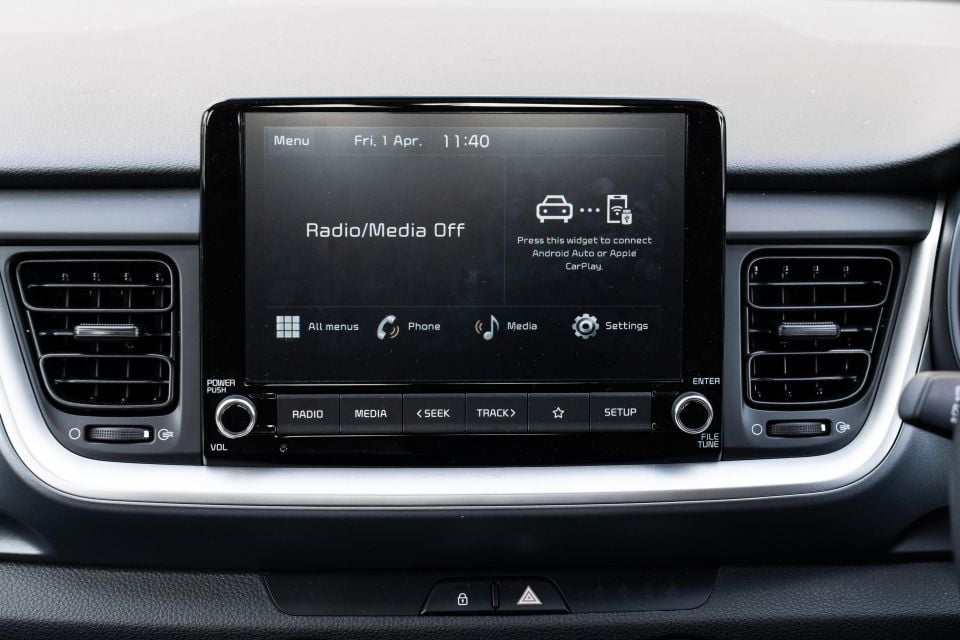
Buy your new car without the stress. It's fast, simple and completely free.

Great service from Travis and team, second time I have used this business would not hesitate to recommend them to anyone
Craig C.
Purchased a Ford Ranger in Sunshine Coast, QLD
CarExpert helped Craig save thousands on his Ford Ranger, now let us save you on your next new car.
Find a dealStonic S highlights
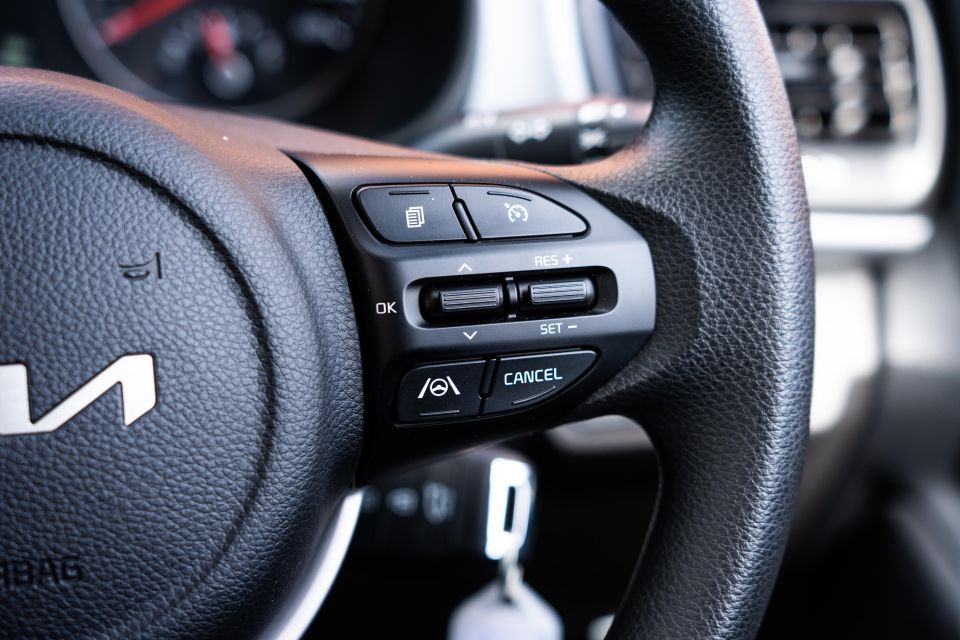
Crucially, the Stonic S adds over the Rio S:
To get these features in the Rio, you need to step up to the mid-range Sport, though even then you won’t get Lane Following Assist.
You will, however, get 17-inch alloy wheels, leatherette-wrapped steering wheel and shifter, and heated, power-folding exterior mirrors in the mid-spec Rio.
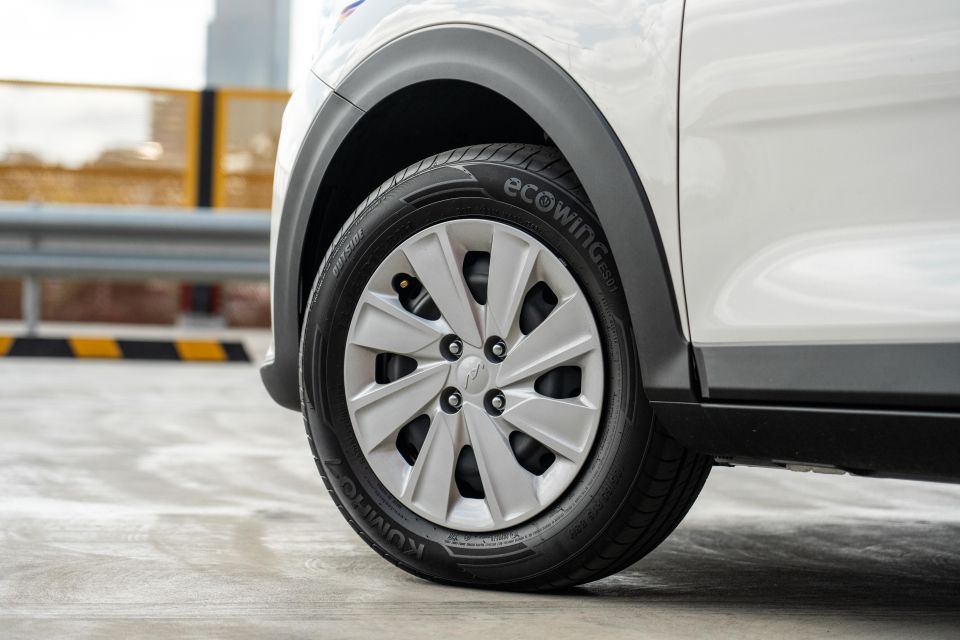
Over the Rio S, therefore, the Stonic S presents a decent if not entirely compelling case for spending an extra $3200. But for $1200 more than a Rio Sport, the Stonic S hardly presents the best value case.
It’s worth noting there are key feature differences across the Stonic line compared with the Rio. For example, the mid-range Stonic Sport gets keyless entry and start and satellite navigation, features not available on any Rio. You pay handsomely for the privilege here, however, with $3800 separating those two models.
Against its two key rivals, the Stonic S offers a better value proposition. The base Venue lacks rear parking sensors, while no Venue offers Lane Following Assist. The Hyundai gets automatic high-beam, but its AEB system doesn’t include cyclist detection.
A CX-3 Neo Sport doesn’t have automatic headlights, but it does get keyless entry and start plus DAB digital radio. An extra $2000 gets you a CX-3 Maxx Sport with blind-spot monitoring and rear cross-traffic alert, features you can’t get on any Australian-market Stonic.

Want proof the Stonic is little more than a Rio in a different suit? Neither ANCAP or Euro NCAP tested the Stonic separately, and its five-star safety rating is based on testing carried out on the Rio in 2017.
It received a frontal offset crash rating of 14.52 out of 16 and a side impact score of 16 out of 16, while whiplash and pedestrian protection were rated Good and Acceptable, respectively.
All Stonic models come with:
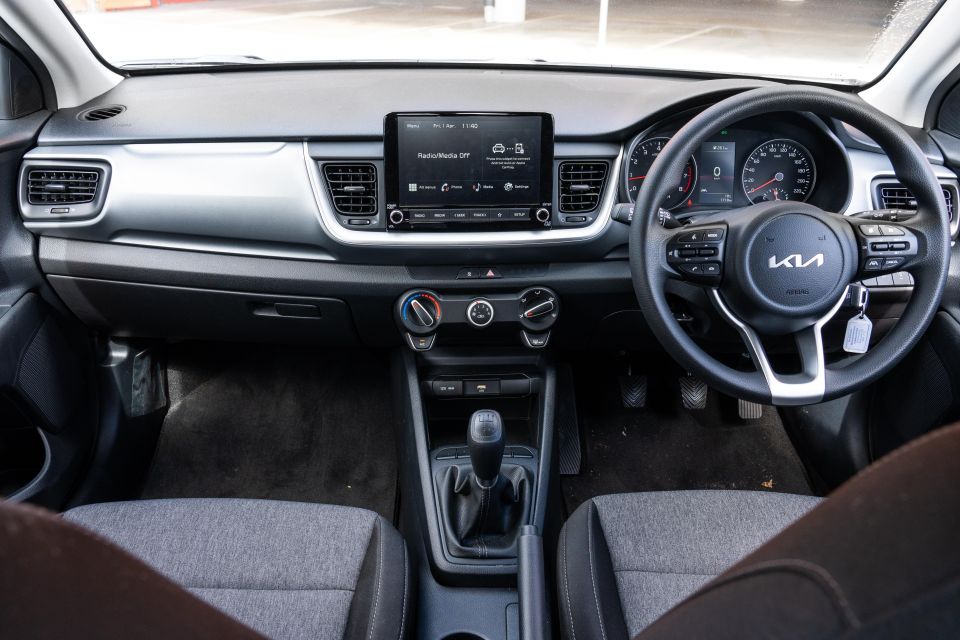
The Stonic doesn’t feel even remotely like an SUV.
You don’t sit all that high, and on one occasion a Mercedes-Benz GLA in the lane next to me appeared to tower over the little Kia. There’s only 25mm of extra ground clearance over the Rio and, overall, an extra 50mm in height.
The Stonic’s interior is lifted almost wholesale from the Rio. That doesn’t mean it’s a bad place to sit, however. Like the Rio, it has a simple, neatly-presented dashboard, laid out in a way we feel drivers of all ages can appreciate.
Controls are placed within easy reach and logically arranged, and you won’t accidentally press the stability control off button as it’s located to the right-hand side of the urethane steering wheel.


The centre stack features two rubberised shelves at the bottom, handy if you and your passenger both want to keep a phone there. I’m sure we’ve all seen the commercial with the two Stonic occupants switching between their two Bluetooth connections – lord knows Kia played it enough.
The 8.0-inch touchscreen infotainment system is well-sized and easy to use, with handy hard shortcut buttons underneath. It features wireless Android Auto and Apple CarPlay, which are nice… when they’re working.
With wireless Android Auto, I got used to the momentary freezing that indicated my wireless connection was about to be dropped. On some days, I’d experience no connectivity troubles, on others it’d be multiple times per trip.
At least over the course of a week the Stonic’s number of dropouts seemed to eventually subside. It was frustrating, however, that when it did and I pressed the connection button on the touchscreen, my music would start playing again even if I had it on pause when the dropout occurred.
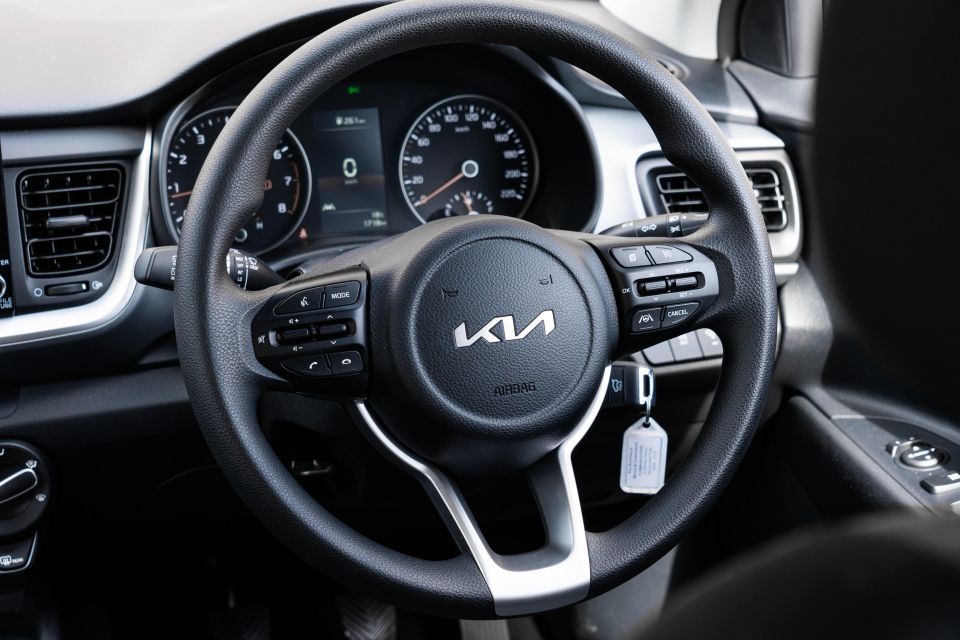

The car won’t turn on your smartphone mirroring application by default, but you can do so with the press of a single button.
Kia does good analogue instrument clusters, and the Stonic is another beneficiary. The gauges are neat and modern, and don’t look they’ll date in a hurry. There’s also an attractive 4.2-inch colour screen between them – credit to Kia for displaying what setting your wipers are on on this screen, something a lot of brands don’t bother with.
While the headliner is a good step above the mouse-fur you’ll find in some entry-level cars, you won’t find any soft-touch plastics on the dash or any kind of soft trim to break up the injection-moulded hard plastic door cards. However, everything looks acceptable for this price point and feels sturdy – with one major exception.
The centre console flexes considerably if you push either side of it, which I found highly unusual given how solidly constructed the rest of the cabin feels.
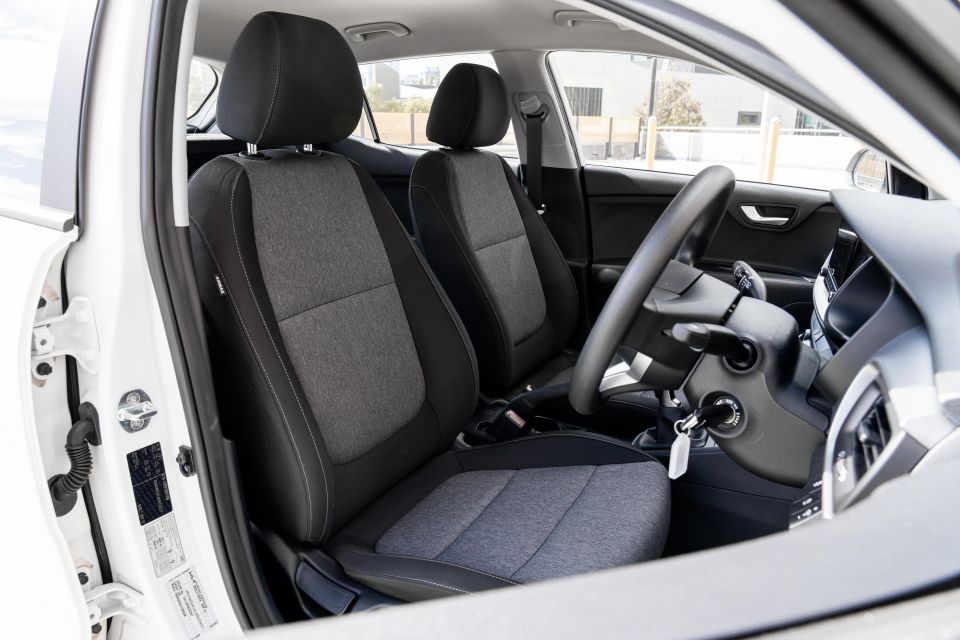
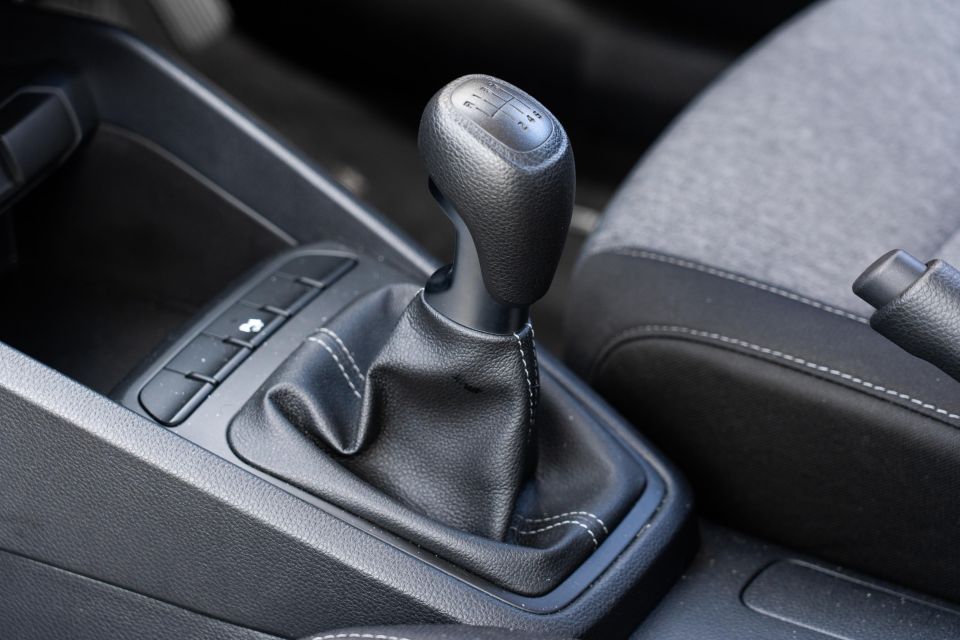
It also lacks a closed bin and armrest like the Stonic Sport and GT-Line, although the open recess where one would sit does at least have a rubberised lining to stop your items from rattling around.
Otherwise, there are few quality gremlins in the Stonic’s cabin, though the glovebox lid does clumsily slam down when opened.
The overall feeling is of a well-built small car, and it doesn’t have a tinny feel to it. Kia even had the sense to make its button blanks symmetrical, unlike the Hyundai Venue Active and Elite. We also didn’t notice any rattles, even over some rotten rural roads.
There’s good visibility out the back and sides and storage is decent, with bottle holders in each door that can fit most 1L bottles plus a map pocket on the front passenger seatback.
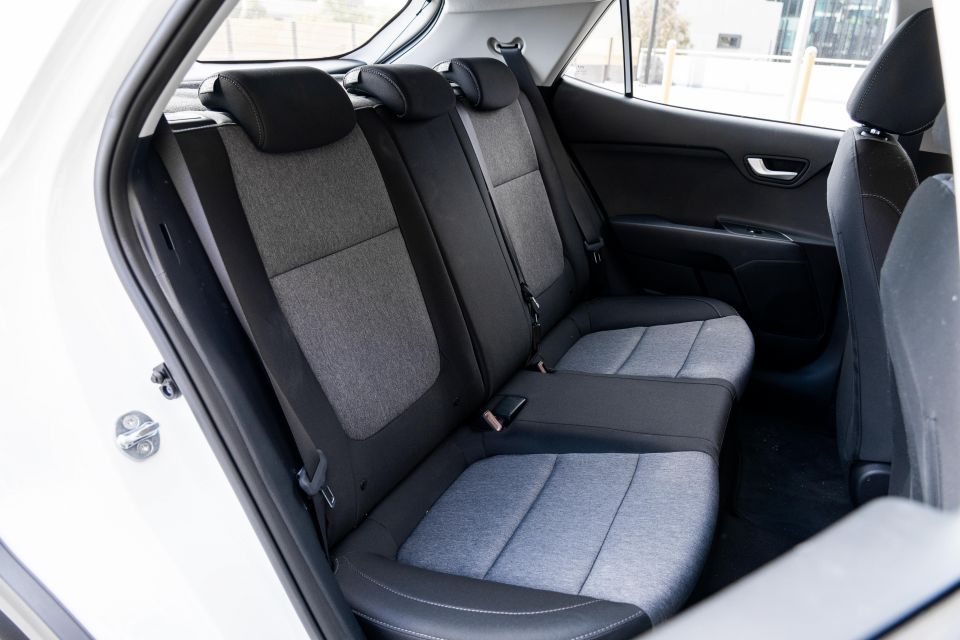
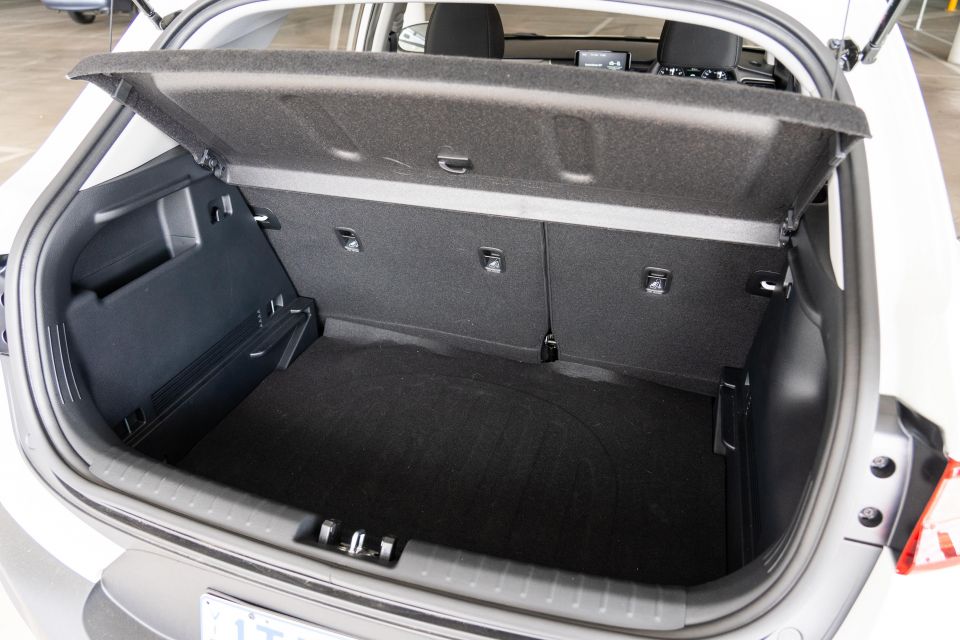
The Stonic shares its wheelbase with the Rio so there’s not really any more space in the back than the cheaper hatch. Leg room and shoulder room measurements are unchanged, while headroom is up by 11mm.
However, the Rio’s back seat is already fairly accommodating for a little car. At 180cm tall, I can sit behind my driver’s seat position with my knees only slightly touching the front seatbacks.
There’s slightly more boot space in the Stonic versus the Rio with 352L, expanding to 1155L with the rear seats folded. That’s up 52L and 77L on the Rio. Seats up, it’s better than the CX-3 (264L) but worse than the boxier Venue (355L).
With the cargo cover removed, I was able to fit two large suitcases stacked on top of each other in the boot, though again this is possible in the Rio. Under the boot floor there’s a space-saver spare.
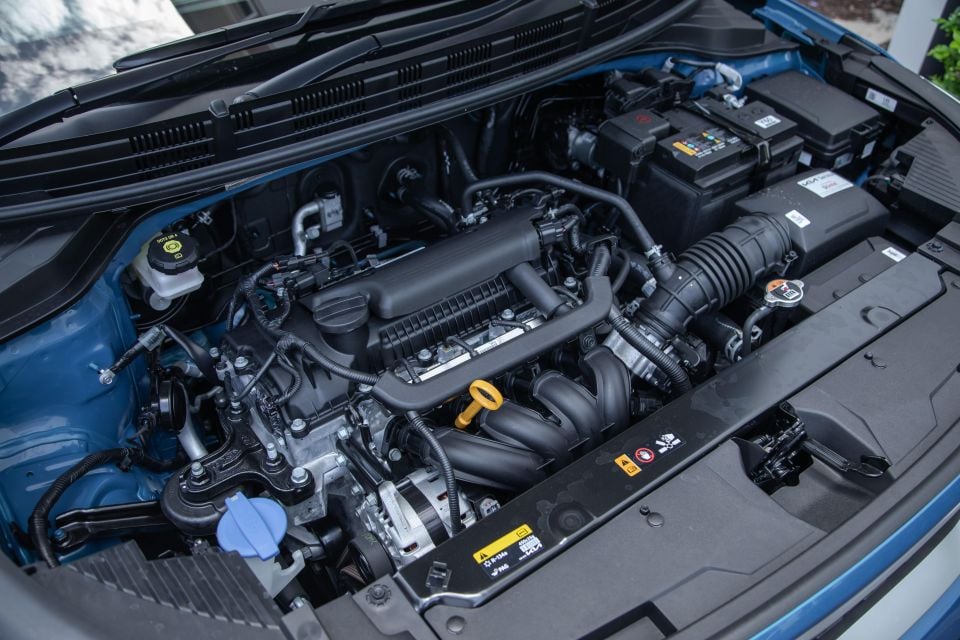
The Stonic is powered by a naturally-aspirated 1.4-litre four-cylinder petrol engine with 74kW of power and 133Nm of torque.
Besides the six-speed manual transmission of our tester, you can get the Stonic S with a six-speed auto. It can also be had with a torquier (74kW/172Nm) turbocharged 1.0-litre three-cylinder engine, but only in range-topping GT-Line guise and exclusively with a seven-speed dual-clutch automatic.
The six-speed manual isn’t a popular choice. Kia Australia told us last year it accounted for just 3.0 per cent of Stonic sales and 4.0 per cent of Rio sales.

Where expert car reviews meet expert car buying – CarExpert gives you trusted advice, personalised service and real savings on your next new car.
The Stonic’s outputs are nothing to write home about. The Hyundai Venue has a 1.6-litre atmo four with 90kW and 151Nm, while the Mazda CX-3 has a 2.0-litre four with 110kW and 195Nm. Even a 20-year old base model Corolla or Pulsar has more power and torque and a better power-to-weight ratio.
In testing last year between a Stonic and a Venue, both equipped with automatic transmissions, we recorded 0-100km/h times of approximately 12.5 and 10.5 seconds, respectively.
In a loop comprising inner-city, suburban and highway driving, we averaged 6.8L/100km. The claimed rating is 6.0L/100km with the manual and 6.7L/100km with the automatic. Over the course of a week, our observed fuel economy eventually reached 7.6L/100km.
It runs on 91 RON regular unleaded fuel and has a 45L fuel tank.

Have you driven a current-generation Kia Rio? If so, you’ve already got a great idea about how the Stonic drives.
It used to be that with small, four-cylinder cars you’d always avoid the automatic option as it’d sap power, use more fuel, and just generally make said car feel less responsive.
Automatic transmissions have improved leaps and bounds over the years, yet the old adage remains true with the Stonic: it’s better with the manual.
Optioned with the automatic, the Stonic is anaemic. It has a droning engine note and a serious lack of punch. The manual helps unlock this powerplant’s potential, and turns the Stonic into something relatively fun to drive.
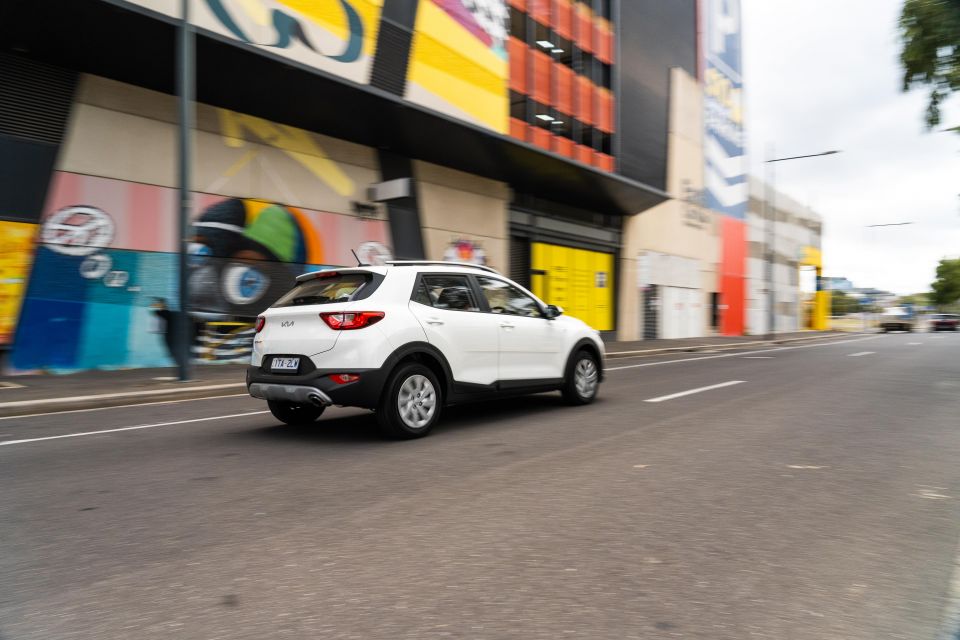
The shifter action is slick and direct without feeling overly light or vague, while the clutch pedal is light enough without making the Stonic feel like a dodgem car. In all, it’s a very easy manual to drive.
Likewise, the steering is nicely weighted and has some feel, and it’s light enough to make inner-city manoeuvring a doddle.
There are no selectable drive modes allowing you to change the weighting of the steering, with drive modes reserved for the top GT-Line, so it’s fortunate the standard set-up is well-sorted.
It’s only 45kg heavier than a comparable Rio, so the engine doesn’t feel any more taxed. The engine note is a bit coarse, and you do hear it toiling away a bit at highway speeds, but you can carry on a conversation at 100km/h on a coarser-chip highway without having to shout – there’s a decent amount of insulation, and wind noise is reasonably well suppressed.
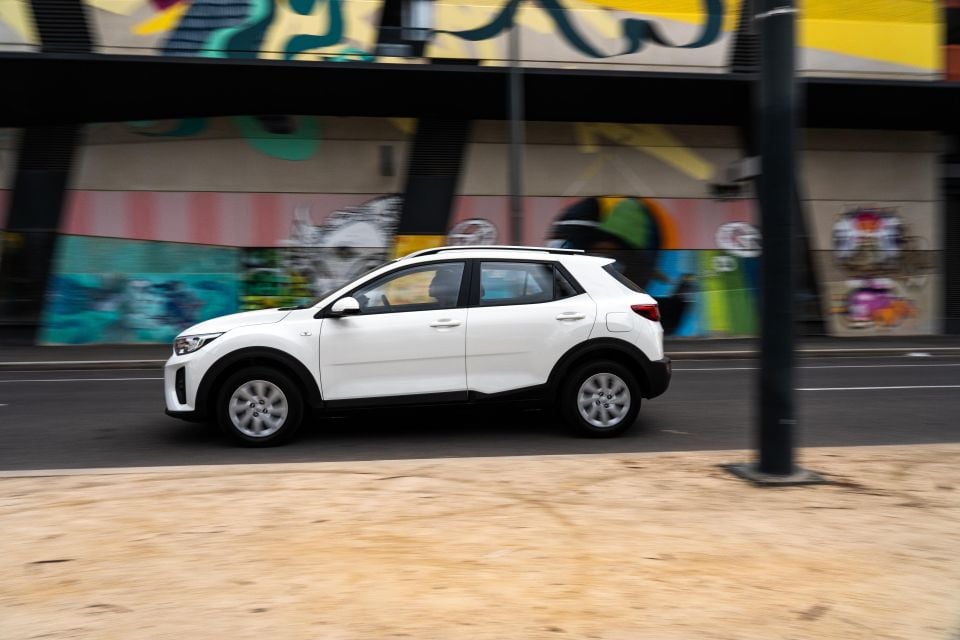
Overtaking on the highway isn’t anxiety-inducing, and being able to row your own gears inspires more confidence in driving this titchy 1.4-litre.
The local suspension tune is ideal for Australia’s often rubbish roads. It’s comfortable on unsealed roads, and the Stonic feels both pliant and planted. It’s on the firmer side of the spectrum and yet the Stonic never seems to crash over bumps and ruts in the road.
It feels poised, with good body control over undulating country roads. We took it on some poorly-surfaced and unsurfaced roads west of Melbourne and found it to be generally comfortable, but the Stonic’s virtual absence of extra ground clearance over the Rio means it doesn’t feel any more suited to dirt roads than its cheaper sibling.
That lack of a noticeably higher centre of gravity, however, means the Stonic drives like a small hatchback, with no body lean and pleasant, neutral handling.
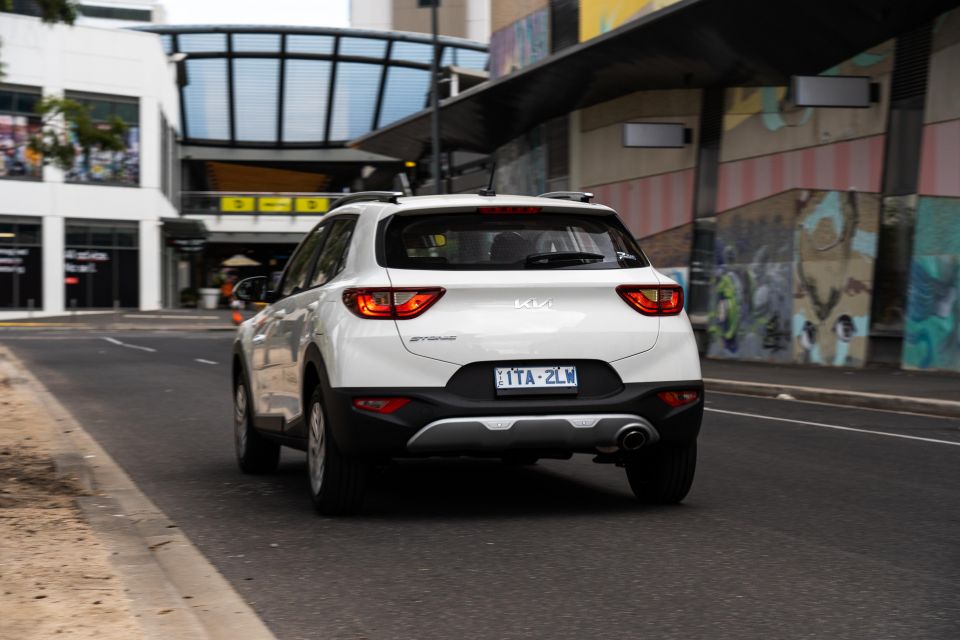
The lane-keep assist can be surprisingly intrusive if effective, and you can see the benefit of it in situations where a driver might be reaching down to grab something from the passenger footwell.
Likewise, the Leading Vehicle Departure Alert flashes a prompt on the instrument cluster screen that the car in front is moving, which is ideal for a driver who’s distracted. Ideally we wouldn’t see these behaviours on the road, but at least these systems can help mitigate them.
The Lane Following Assist works as well as it usually does in Kia products but would benefit from being mated with an adaptive cruise control system. The standard cruise control unusually doesn’t have a readout to say what speed you’ve set it to either.
A rarity for an Australian-market Kia, the Stonic manual features idle stop/start. This activates when you shift the car into neutral. It operates quite smoothly, and avoids shaking the car.
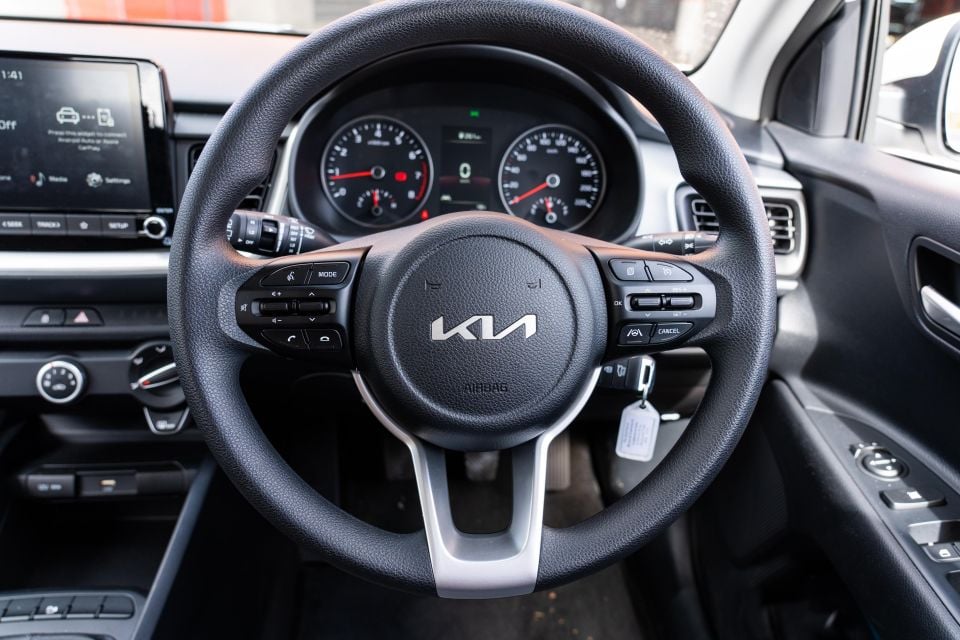
In addition to a seven-year, unlimited-kilometre warranty, Kia offers seven years of capped-price servicing for the Stonic.
The first five services are capped at $269, $455, $323, $608 and $303, with intervals of 12 months or 15,000km, whichever comes first.
That puts the Stonic’s total servicing cost for five years at $1958. A CX-3 Neo Sport costs $1839 over five years, albeit with shorter intervals of 12 months/10,000km, while a Venue costs $1575.
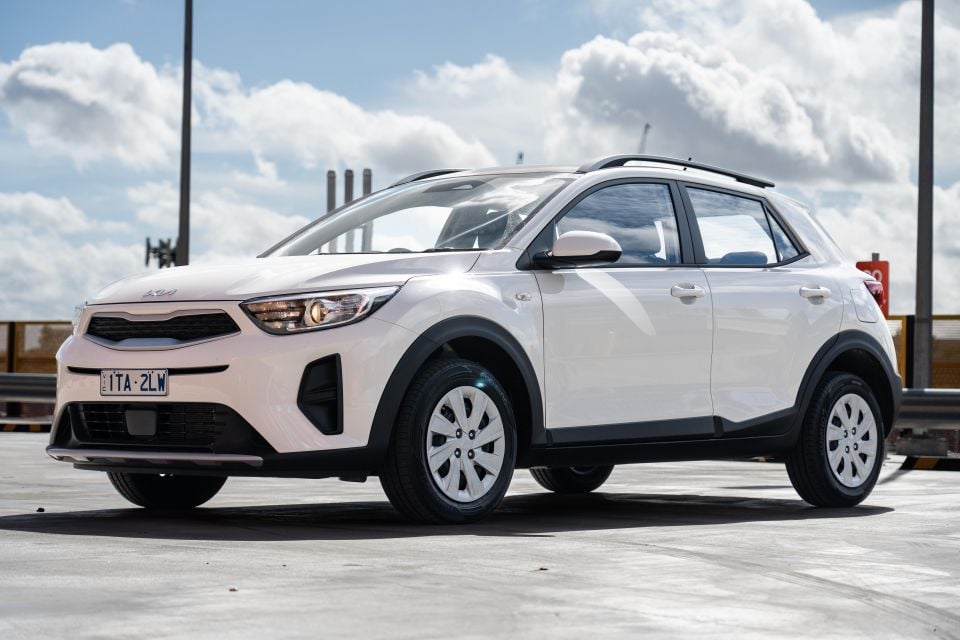
It’s a shame most buyers will overlook the Stonic’s manual option, in favour of the pricier, less efficient, likely slower and less appealing automatic.
With the manual, it’s vastly more enjoyable to drive and puts Kia’s entry-level SUV in a better light. The Stonic is already attractive inside and out, boasts a spacious interior for something this size, and has a well-judged ride and handling balance.
But do you know what else has all of that and a lower price? A Kia Rio. Ignore the base S variant with its missing AEB and go for the mid-range Sport and you’re still paying less than you would for a base Stonic, while getting almost all its features plus a few extra niceties.

With the Rio, you sacrifice a tiny bit of headroom and a little bit of boot space but you get a better deal.
That’s not to say the Stonic is of poor value relative to its competitors. The Venue misses out on some of the Stonic’s features, though it has a more powerful engine; the CX-3 has more power still, but it has a tighter back seat. Between the three, it’s almost a wash.
The Stonic offers no more versatility than a Rio and you barely even sit higher. Unless you’re a candidate for a hip replacement – in which case something like a Mitsubishi ASX would likely be better – we recommend you pocket the extra money and get a Rio Sport.

Click the images for the full gallery
MORE: Everything Kia Stonic
Where expert car reviews meet expert car buying – CarExpert gives you trusted advice, personalised service and real savings on your next new car.
William Stopford is an automotive journalist with a passion for mainstream cars, automotive history and overseas auto markets.


Damion Smy
9 Hours Ago


Damion Smy
11 Hours Ago


Damion Smy
12 Hours Ago


Damion Smy
14 Hours Ago


Damion Smy
15 Hours Ago


Damion Smy
17 Hours Ago